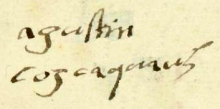Cozcacuauh (MH630r)
This black-line drawing of the compound glyph for the personal name Cozcacuauh ("King Vulture," attested here as a man's name) shows the head of an eagle in profile, looking toward the viewer's right. Its eye and beak are open. The necklace (cozcatl) at the eagle's neck is a phonetic indicator that this is not an eagle but a cozcacuauhtli, vulture.
Stephanie Wood
This is a day sign in the tonalpohualli, the 260-day divinatory calendar. Normally, the vulture would have a numerical companion from 1 to 13, but the number has been inadvertently dropped or suppressed. Calendrics figure importantly in Nahuas' religious views of the cosmos.
Stephanie Wood
agustin
coscaquauh
Agustín Cozcacuauh
Stephanie Wood
1560
Jeff Haskett-Wood
calendarios, días, birds, pájaros, vultures, buitres, joyas, cuentas, collares, águilas, nombres de hombres, nombres de días

cozcacuauh(tli), vulture, https://nahuatl.wired-humanities.org/content/cozcacuauhtli
cozca(tl), necklace, https://nahuatl.wired-humanities.org/content/cozcatl-0
cuauh(tli), eagle, https://nahuatl.wired-humanities.org/content/cuauhtli
Buitre
Stephanie Wood
Matrícula de Huexotzinco, folio 630r, World Digital Library, https://www.loc.gov/resource/gdcwdl.wdl_15282/?sp=342st=image.
This manuscript is hosted by the Library of Congress and the World Digital Library; used here with the Creative Commons, “Attribution-NonCommercial-ShareAlike 3.0 License” (CC-BY-NC-SAq 3.0).







